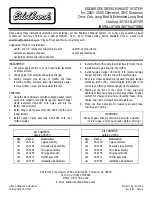
48
Adaptive brake light
Active at speeds above 50 km/h, the adaptive
brake light can sense the difference between
normal and panic braking. If it is a panic situation,
all the brake lights will flash at a rate of four
times per second. Once your speed slows to
below 10 km/h, the lights stop flashing and
hazard lights flash instead. Using LED technology
that needs less time to light up than regular
bulbs, traffic behind you can react sooner.
SAFETy
At the core of every car we make, state-of-the-art technology helps support the driver and
protect the occupants. And to further enhance the Volvo safety experience, there’s a range of
supplementary safety technology – for more performance and peace of mind.
SAFETy
Preventive
water-repellent front side windows
To help offer far better visibility in the rain, these front side windows help repel water as you drive.
The hydrophobic surface treatment turns water into small drops that will be blown away by the force of
the wind. This also gives you the benefit of less ice or frost in winter conditions.
Intelligent Driver Information System (IDIS)
To help avoid distractions during critical driving situations, IDIS constantly analyses your driving and will
delay secondary information from the car or one of its onboard systems – such as the GSM phone –
when it detects intense steering, braking or acceleration. As soon as things calm down, the phone call
or the delayed information is presented. IDIS can be set up to let GSM calls through in all driving situations.
Dynamic Stability and Traction
Control (DSTC)
By helping prevent fishtails, spinouts, and
rollovers, stability control technology like DSTC
has been described as one of the most vital
safety advances of the past decade. At the
core of DSTC, a gyroscope senses the car’s
direction and compares this with steering wheel
movements as well as the actual rotation of the
car’s wheels. DSTC is able to detect a potential
skid and help counteract this one by reducing
the engine’s power output, or braking on one
or more wheels.
49
Dual Xenon lights
The headlamps combine separate reflectors to provide even and effective illumination in all conditions.
For even better night vision, there’s the option of Dual Xenon gas discharge lamps. Compared to conventional
halogen headlamps, Dual Xenon headlights expand your vision range by about 230%. This means you’ll
gain a further 45 metres for braking. Independent of the load, these headlights self-adjust to maintain
the correct angle to the road – even during hard acceleration or braking.
Active Bending lights (ABl)
In addition to improving illumination by about
230% using Dual Xenon light technology, the
Active Bending Lights give a 90% boost to
your vision round bends at night. Controlled by
microprocessors, the motorised lamps turn up
to 15 degrees in either direction when driving
– reliably lighting up your chosen path. A twilight
sensor disengages the adaptive function during
daylight to extend its life span.
SAFETy
Preventive
SAFETy
Protective
Restraint technologies
In a collision, Volvo’s restraint technologies interact to help reduce the impact. The
safety belts with
pre-tensioners
activate within a few thousandths of a second in the event of a collision and tighten the
belt to help keep the occupants securely restrained. The front seat safety belts then release a little so
that the driver and passenger are cushioned by the airbags in a controlled manner. Helping to optimise
protection, the
dual-stage airbags
adapt the level of inflation depending on the force of the collision.
The driver’s airbag also interacts with the deformation of the collapsible steering column.
Side airbags
in the front seats help reduce the risk of serious injuries in a side collision. The
Inflatable Curtain (IC)
helps protect the heads of both front and rear outboard occupants. It also stays inflated for some seconds
to provide prolonged protection for subsequent impacts.
passenger airbag cut-off switch
This switch allows you to disengage the passenger airbag
using the car key. When the airbag is switched off, you are
notified via a message in the roof console display. The force
of the passenger airbag is designed to help protect adults
– children risk serious injury. Therefore, the airbag must first
be disengaged if you intend to put a person shorter than
140 cm in the front passenger seat.










































